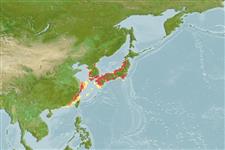Elasmobranchii (Haie und Rochen) (sharks and rays) >
Carcharhiniformes (Ground sharks) >
Triakidae (Houndsharks) > Triakinae
Etymology: Triakis: tri-, from tres (L.), three; akis (Gr.), point, referring to each tooth consisting of one large central cusp flanked on by both sides by a small cusplet. (See ETYFish); scyllium: From skylion, Greek for dogfish or small shark. (See ETYFish).
More on authors: Müller & Henle.
Environment: milieu / climate zone / depth range / distribution range
Ökologie
seewasser; brackwasser demersal. Subtropical; 48°N - 20°N
Northwest Pacific: southern Siberia to Taiwan (Ref. 244). Nominal records from the Philippines (Ref. 13563).
Length at first maturity / Size / Gewicht / Alter
Maturity: Lm 103.5, range 99 - 108 cm
Max length : 150 cm TL Männchen/unbestimmt; (Ref. 244)
Found on the continental and insular shelves, often occurring in shallow water close inshore. Prefers estuaries and shallow bays, especially sandy and algal-covered areas and eelgrass flats. Feeds on small fishes and probably crustaceans and other benthic invertebrates. Often solitary, though some may cluster in resting areas on bottom. Ovoviviparous (aplacental), with 10 to 20 young in a litter. Meat is regarded as of inferior quality.
Ovoviviparous, embryos feed solely on yolk (Ref. 50449).
Compagno, L.J.V., 1984. FAO Species Catalogue. Vol. 4. Sharks of the world. An annotated and illustrated catalogue of shark species known to date. Part 2 - Carcharhiniformes. FAO Fish. Synop. 125(4/2):251-655. Rome: FAO. (Ref. 244)
IUCN Rote Liste Status (Ref. 130435)
Nutzung durch Menschen
Fischereien: weniger kommerziell
Mehr Information
ReferenzenAquakulturAquakultur ProfilZuchtlinienGenetikElectrophoresesVererbbarkeitKrankheitenVerarbeitungNutrientsMass conversion
PartnerBilderStamps, Coins Misc.LauteCiguateraGeschwindigkeitSchwimmstilKiemenoberflächeOtolithsGehirngrößeSehfähigkeit
Tools
Zusatzinformationen
Download XML
Internet Quellen
Estimates based on models
Preferred temperature (Ref.
123201): 14.8 - 21.8, mean 18.8 °C (based on 52 cells).
Phylogenetic diversity index (Ref.
82804): PD
50 = 0.5312 [Uniqueness, from 0.5 = low to 2.0 = high].
Bayesian length-weight: a=0.00240 (0.00110 - 0.00521), b=3.14 (2.96 - 3.32), in cm total length, based on LWR estimates for this (Sub)family-body shape (Ref.
93245).
Trophic level (Ref.
69278): 3.8 ±0.2 se; based on diet studies.
Generation time: 6.7 ( na - na) years. Estimated as median ln(3)/K based on 2
growth studies.
Widerstandsfähigkeit (Ref.
120179): niedrig, Verdopplung der Population dauert 4,5 - 14 Jahre. (Fec=10; K=0.16; tmax=20.6).
Fishing Vulnerability (Ref.
59153): High vulnerability (64 of 100).
